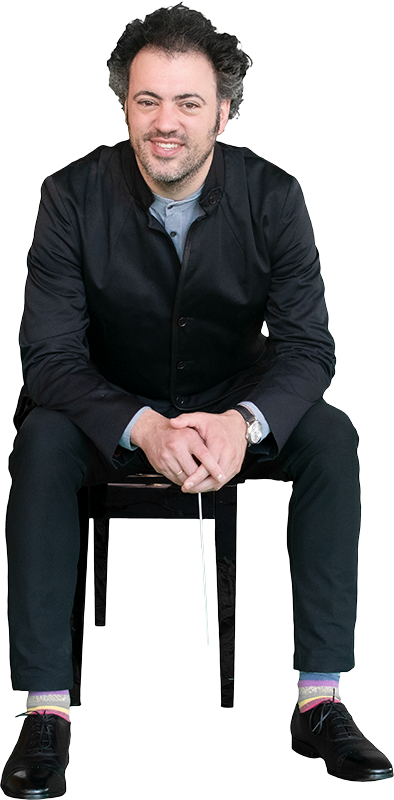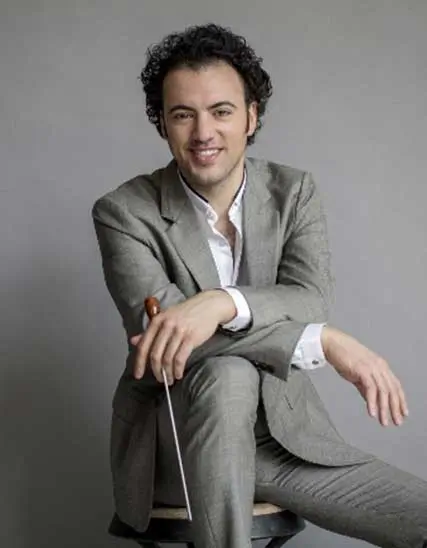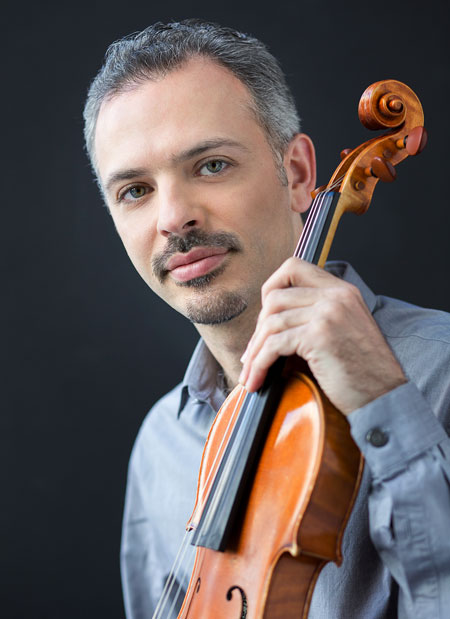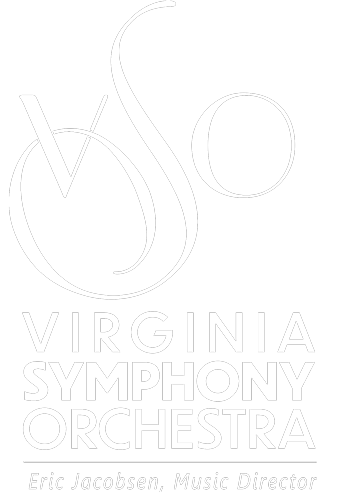What about the music?
An inside look with the Virginia Symphony Orchestra
Beethoven Celebration with Eric & Colin Jacobsen
Friday, September 20, 2024 7:30PM | Chrysler Hall
Saturday, September 21, 2024 7:30PM | Ferguson Center
Ludwig van Beethoven: Coriolan Overture
Ludwig van Beethoven: Symphony No. 4
Ludwig van Beethoven: Violin Concerto
By Stella Feliberti

The Performers

Meet our Conductor
Eric Jacobsen
Hailed by the New York Times as “an interpretive dynamo,” conductor and cellist Eric Jacobsen has built a reputation for engaging audiences with innovative and collaborative programming. He is the newly-named Music Director of the Virginia Symphony, becoming the 12th music director in the orchestra’s 100-year history.
Jacobsen is Artistic Director and conductor of The Knights, and serves as the Music Director for the Orlando Philharmonic Orchestra. Jacobsen founded the adventurous orchestra The Knights with his brother, violinist Colin Jacobsen, to foster the intimacy and camaraderie of chamber music on the orchestral stage. Eric splits his time between New York and Orlando with his wife, singer-songwriter Aoife O’Donovan, and their daughter.

Violin
Colin Jacobsen
Violinist and composer Colin Jacobsen is “one of the most interesting figures on the classical music scene” (Washington Post). Since the early 2000’s, Jacobsen has forged an intriguing path in the cultural landscape of our time, collaborating with an astonishingly wide range of artists across diverse traditions and disciplines while constantly looking for news to connect with audiences. For his work as a founding member of two game-changing, audience-expanding ensembles – the string quartet Brooklyn Rider and orchestra The Knights – Jacobsen was selected from among the nation’s top visual, performing, media, and literary artists to receive a prestigious and substantial United States Artists Fellowship. He is also active as an Avery Fisher Career Grant-winning soloist and has toured with Silkroad since its founding by cellist Yo-Yo Ma in 2000 at Tanglewood. Starting in the 2022/23 season, Jacobsen assumes the position of Artistic Director of Santa Fe Pro Musica, an organization with which he has had a fruitful long term association as a guest soloist and leader.
A graduate of the Juilliard School and the Royal Conservatory of the Hague, Jacobsen’s principal teachers have included Doris Rothenberg, Louise Behrend, Robert Mann and Vera Beths.
Colin Jacobsen plays a Joseph Guarneri filius Andreae violin dating back from 1696 and a Samuel Zygmuntowicz violin made in 2008.
The Creator

Ludwig von Beethoven
Pronounced LOOD- VIG VAN BAIT- OH-VEN
Fast Facts:
- Beethoven started composing around age 9 and published his first compositions in 1783.
- Beethoven started to study under Franz Joseph Haydn in 1792 where he took counterpoint lessons and studied violin.
- Beethoven only wrote 9 symphonies, starting a ‘curse’ for Romantic Era composers. Like Beethoven, composers like Schubert, Mahler, Bruckner, and Dvořák all died leaving exactly 9 symphonies in their repertoire.
- Beethoven is known for leading the transition from the Classical Era into the Romantic Period, leading to his high regard as one of the most famous composers of all time.
- While most consider Beethoven to be completely deaf by his later symphonies, including the 7th Symphony played on this concert, he did not lose his hearing completely until 1826 when his String Quartet in B-flat Op.130 premiered.
Coriolan Overture
Listen to the Coriolan Overture by the Frankfurt Radio Symphony
Vocab Terms:
- Overture: an orchestral introduction to a larger work. Usually occurs in operas, suites, or plays
- Programmatic music: a piece of music that tries to musically render a narrative or image
Fast Facts:
- Beethoven’s Coriolan Overture was written in 1807 for Heinrich Joseph von Collin’s tragedy Coriolan. Coriolan is a play based on Shakespeare’s text Coriolanus. It was premiered at a private concert at the home of Prince Lobkowicz.
- This overture is considered programmatic as the melodies represent the characters and storyline of Coriolan.
Originally composed for Heinrich von Collin’s unsuccessful play Coriolan, Beethoven’s more successful Coriolan Overture is a lively depiction of Shakespeare’s tragedy, Coriolanus. In the Shakespearean tragedy, the Roman General, Coriolanus, is banished from Rome and joins the enemy to defeat Rome, only to be betrayed by his new allies. Beethoven illustrates the strife of Coriolanus as he struggles with the corruption of Rome and his exile, to his turn to the enemy for solace only to be betrayed. Thus, with this musical depiction of the work, the Coriolan Overture is “programmatic,” meaning the music encompasses a scenic description or literary idea.
The overture opens with a dark and turbulent melody, showing Coriolanus’ rebellious nature. The second theme the enters more gently and compassionately, imitating the nature of Volumnia, Coriolanus’ mother. As Volumnia’s theme develops, it seems as if Volumnia wins Coriolanus over to make peace with Romans. However, the stormy opening theme returns, and the music falls apart, exemplifying the betrayal of Coriolanus’s new allies to him. The overture fades away as Coriolanus dies after falling on his sword. The Coriolanus Overture is an engaging and vibrant is a whirlwind of a piece, making it a great example of programmatic musical literature.
Symphony No. 4 in B flat Major
Listen to Beethoven’s Symphony No. 4 by the Frankfurt Radio Symphony
Fast Facts:
- Beethoven’s Symphony No.4 was written in 1806 and premiered in 1807 in a private concert at the house of Prince Lobkowicz.
- This symphony is often overlooked by commentators because it does not share the same musical weight as Beethoven’s 3rd or 5th Rather, this symphony is known for its warm tone.
- Berlioz, Mendelssohn, and Schumann admired Beethoven’s 4th symphony greatly, despite audiences preferring the Beethoven’s 3rd and 5th symphony.
- There are 4 movements in this symphony: Adagio – Allegro vivace, II. Adagio, III. Scherzo-trio: Allegro vivace, and IV. Allegro ma non troppo.
Though often neglected by commentators due to the acclaim of Beethoven’s 3rd and 5th symphonies, Beethoven’s Symphony No.4 is known for its candor and contained power it carries through each movement of the symphony. Composer Robert Schumann describes this work as “a slender Greek maiden between two Norse giants,” noting the 4th Symphony’s overlooked status compared to Beethoven’s 3rd and 5th symphonies. However, Schumann also recognizes the beauty of the 4th Symphony’s simple style that the Romantic period took from the Enlightenment. The more subdued orchestration and character of Beethoven’s 4th Symphony allows for the melodic charm to shine and capture audiences.
The symphony opens suspensefully as Beethoven avoids the home key of the symphony for 42 measures. Cycling through various keys, the piece slowly unfurls until the home key of B-flat is finally reached. The 2nd movement encompasses an accompaniment figure that threads through each of Beethoven’s themes throughout the movement, adding an endearing quality. Contrasting the 2nd movement, the 3rd movement’s Menuetto is full of energy while its trio is more lyrical. To close the symphony, Beethoven continues the energetic quality from the 3rd movement by creating an infectious joviality throughout the 4th. This symphony illustrates the charisma, directness, and emotional diversity of early Romantic music and the unique style of Beethoven; it is a great introduction into the compositional genius of Beethoven as this symphony wraps up his personality into a straightforward and engaging piece.
Violin Concerto in D Major
Listen to Beethoven’s Violin Concerto by the Detroit Symphony with soloist Hilary Hahn
Vocab Terms:
- Theme: a primary melodic idea of a composition
- Thematic Expansion: the development of a melodic idea through variation in its harmony or rhythm
- Concerto: a piece with one or more soloists with an orchestra. Usually ranges from 2-5 movements
Fast Facts:
- Beethoven’s Violin Concerto was written in 1806. At this time, he also wrote some of his best-known works including the 4th Piano concerto, the “Razumovsky” string quartets, his 4th and 5th symphonies, and the “Appassionata” Piano Sonata
- The concerto was commissioned by violinist Franz Clement. It is said that Clement received the score only two days before the premiere, which is why some speculate he sight-read some of the concerto during the performance
- After the premiere, the concerto was neglected by performers until Joseph Joachim resurrected it under the baton of Felix Mendelssohn
- The concerto has three movements: the first movement is a cheery yet assured Allegro. The second movement, Larghetto, is a touching set of variations. The third movement is buoyant Rondo. The entire concerto is approximately 42 minutes.
Unlike most concertos, Beethoven’s Violin Concerto includes a expressive thematic expansion in both the orchestral and soloist part. After writing 4 symphonies, Beethoven elaborated upon his symphonic structures by combining his effortless expansion of thematic material coincided with elegant elaborations from the soloist. Beethoven dedicated this concerto to violinist Franz Clement, who commissioned the work. He premiered the work in 1806 where some speculate that Clement sight-read his part during the premiere as he only received the score two days before the premiere. After this premiere, there was limited performances of the work due to its lack of traditional violin concerto flair. It as only until violinist Joseph Joachim revived the work in 1844 with Mendelssohn conducting that it became popular once again. Now, the Beethoven’s Violin Concerto is part of the standard concerto repertoire for violinists, and one of the most adored pieces in the repertoire.
The concerto opens with a surprising four drum tamps from the timpani, creating a seemingly menacing “knocking” motif. Yet, when the oboe enters after the timpani, Beethoven introduces a cheery and singing theme. Once the soloist enters after a flourishing orchestral opening, it is revealed that the opening timpani beats are an integral part to the thematic material of the 1st movement. The 2nd movement encompasses the poetic nature of the 1st movement, except embracing simplicity and beauty with groups of themes and variations. As the final variation is hinted at by the horns, the soloist takes back over into a cadenza, a virtuosic solo passage, to end the movement. The final movement contrasts the first two movements with it energetic and tuneful melody that seamlessly flows and develops. This concerto is a whirlwind of tuneful themes and variations that highlights the interplay between soloist and orchestra.
